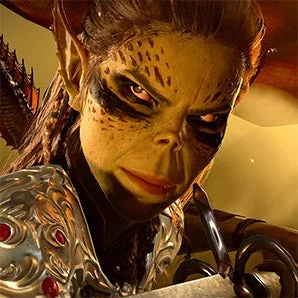Baldur’s Gate 3 Gets Accessibility Mostly Right, But There’s Still Room to Improve
Estimated reading time: 6 minutes
It’s August and the only game I’ve consistently played is Baldur’s Gate 3. I can’t stop thinking about progressing in my multiple campaigns, unraveling new secrets and areas, and even determining which character best suits a specific conversation. And as someone who’s unsuccessfully tried numerous times to play tabletop D&D because of a lack of interest, I was initially apprehensive about playing the video game version. Thankfully I’ve never been more wrong.
I have three campaigns I’m currently running – a Storm Sorcerer obsessed with the arcane, a Paladin who ironically broke his oath merely 30 minutes into his adventures, and a charismatic Bard who is very eager to let Astarion continue to bite his neck. With every decision I make across my adventures, Baldur’s Gate 3 demonstrates the importance of accessible design, especially when a game can be so overwhelming. For this month’s Access Designed, I want to highlight the need for cognitive accessibility, and why Baldur’s Gate 3, despite my adoration, is a deeply complex title.
Physical Accessibility
Before I truly dive into my critiques and concerns from a cognitive accessibility standpoint, I want to praise Larian Studios for its work regarding physical accessibility. Despite the plethora of keys and buttons that perform varying commands like abilities, camera control, and inventory management, every major action can be completed with just the mouse. As someone with a progressive disease and weakened muscles, it’s increasingly disheartening to need to take breaks from expansive titles. I never want to stop gaming with friends because of my limitations, and having the capability to conserve energy while simultaneously playing for hours is one of the best parts about this game. It doesn’t matter if my body is too exhausted to press multiple keys, nor do I need to schedule sessions during peak energy levels. If my friends are ready to jump in, so am I, and it’s all because of mouse controls.
Cognitive Accessibility Benefits
Baldur’s Gate 3’s cognitive accessible designs and features are both beneficial and detrimental to every player’s experience. As I mentioned before, its relationship with this level of accessibility is multifaceted. Depending on your preferred playstyle, the barriers that disabled players may encounter vary from minor inconveniences to full blockers.
I’ve excessively discussed and explored the benefits of inclusive design. Too often is a game’s merit judged solely on the dozens of options fit into menus labeled specifically for accessibility. And while Baldur’s Gate 3 does offer an excellent array of settings, its best use of inclusive design comes with co-op campaigns.
There are hundreds, if not thousands of decisions that players will make across their adventures. From brief interactions with travelers on the road to impactful conversations at major settlements, each dialog option has the potential to drastically change the trajectory of missions. Currently, two of my three campaigns are played with friends, and the stress of needing to accurately predict which outcome best suits the party is all but gone. With my Bard, my friends and I agreed to run a “chaotic” adventure, one where our entire goal is to make each other laugh with outlandish choices. My only job is to persuade or swoon at others. It doesn’t matter if one of my dialogue options forces a group against us. If it causes chaos, I’ve succeeded.
While Baldur’s Gate 3 does offer an excellent array of settings, its best use of inclusive design comes with co-op campaigns
Beyond just eliminating the need to fixate on conversations, having more players independently control themselves affords more opportunities to discover new areas or items, or even succeed at different world events like lockpicking or puzzle solving. The entire weight of your campaign is no longer on your shoulders. While a chaos adventure isn’t always the most appropriate solution, it demonstrates the sheer flexibility that each Baldur’s Gate 3 run is ultimately whatever you want it to be, especially with friends.
Cognitive Accessibility Barriers
Remember everything I just said about Baldur’s Gate 3? Those inclusive design decisions and accessibility benefits drastically reduce the less players you have in your campaign. And if you’re playing alone, every interaction, decision, discovery, or combat scenario is a direct result of your actions. Yes, there are numerous tutorials, and even a journal to keep track of quests and important information, but the paralyzing feeling of making the wrong choice will persist.
Do I have enough magical artifacts for Gale to consume? Am I equipping my party with the best gear possible? Who has the best Perception to detect traps and valuables in this cave? Do I really need to let Astarion bite my neck? Every time I play by myself, I struggle to not fixate on every minute detail. And for those with varying cognitive disabilities, especially ones related to analysis paralysis, Baldur’s Gate 3 has the potential to be a constant overloading experience.
While there are some solutions like playing with friends or even the debatable aspect of ‘save scumming’, there is little in terms of cognitive accessibility designs or options for single players. This doesn’t necessarily mean that Baldur’s Gate 3 is a completely inaccessible game – remember, the disabled experience is incredibly individualistic. As a physically disabled player, it’s almost perfect for my specific needs.
I don’t have all of the answers on what designs or features cognitively disabled players need to enhance their experience. But I do know that cognitive accessibility is rapidly gaining interest and attention across the industry. From the Dead Space remake, to Celeste, to Grounded’s Arachnophobia settings, accessibility is encompassing more than physical, visual, and aural.
Baldur’s Gate 3 should be praised for its accessibility successes, but also criticized, especially when it falls short. Openly discussing its flaws isn’t indicative of a failed product. Rather, it creates further discussions for players and developers to understand where accessibility needs aren’t being met. For me, it’s quickly becoming my Game of the Year. But that doesn’t mean I can’t highlight concerns for others. No game will ever be perfect for accessibility, and Baldur’s Gate 3 is indicative of an industry needing to grow.
Grant Stoner is a disabled journalist covering accessibility and the disabled perspective in video games. When not writing, he is usually screaming about Pokémon or his cat, Goomba on Twitter.









Post Comment